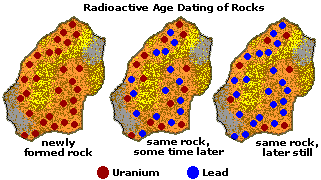|
How
Old is That Rock?
How can you tell the age of a rock or to which geologic time period
it belongs? One way is to look at any fossils the rock may contain.
If any of the fossils are unique to one of the geologic time periods,
then the rock was formed during that particular time period. Another
way is to use the "What's on top?" rule. When you find
layers of rocks in a cliff or hillside, younger rocks are on top
of older rocks.
But
these two methods only give the relative
age of rocks--which are younger and which
are older. How do we find out how old
a rock is in years? Or how do we know
how long ago a particular group of fossilized
creatures lived?
The age of a rock in
years is called its absolute age. Geologists find absolute ages
by measuring the amount of certain radioactive elements in the rock.
When rocks are formed, small amounts of radioactive elements usually
get included. As time passes, the "parent" radioactive
elements change at a regular rate into non-radioactive "daughter"
elements. Thus, the older a rock is, the larger the number of daughter
elements and the smaller the number of parent elements are found
in the rock.

 A
common "parent-daughter" combination that geologists use
is radioactive uranium and non-radioactive lead. As shown in the
diagram above, uranium is trapped in a newly formed rock. As the
rock ages, more and more of the uranium changes into lead. A
common "parent-daughter" combination that geologists use
is radioactive uranium and non-radioactive lead. As shown in the
diagram above, uranium is trapped in a newly formed rock. As the
rock ages, more and more of the uranium changes into lead.
The age of the rock in
years can be found by measuring the rate at which a parent element
decays and then measuring the ratio of parent element to daughter
element in the rock. The ages in years of the different geological
time periods are found by measuring the absolute ages of many rocks
from all of the different periods. The absolute ages of some of
the different geologic time periods are shown along the right side
of the Staircase of Time.
The
steps of the Staircase of Time are drawn
to be almost the same size, so you might
think that the time periods are the same
length, but they are not. The absolute
ages of rocks taken from the different
time periods have shown that the time
periods were of greatly differing lengths.
Some were very short, like the Quaternary
period (only 2 million years), while others
were very long, like the Proterozoic Era
(almost 2 billion years). According to
absolute-age measurements, an accurate
representation of the lengths of the major
geologic time periods is shown in the
time bar at right.
Back
| Next
|











